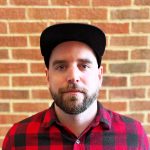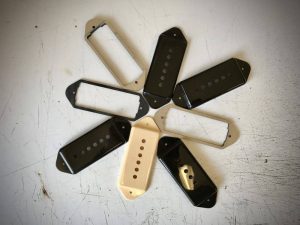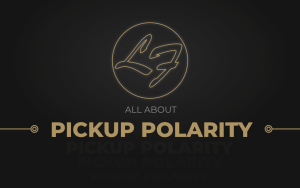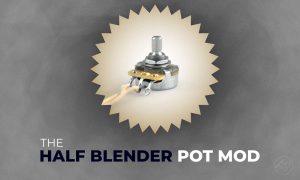
Understanding D.C. Resistance For Guitar Pickups
D.C. Resistance, or a pickup’s Ohm reading, is not the “Holy Grail” of understanding a pickup’s output – it will give you a rough understanding.
On occasion, we get a customer’s email stating that “their 8.2K Pure P.A.F. bridge reads 8K – What’s Wrong?” The answer is simply “Nothing at all.” There are a lot of variables that can make the same pickup provide different readings. However, there are more important things to take note of – at Fralin Pickups, we count turns rather than rely on ohm readings. Let’s learn a little bit about Ohm readings and what they mean for your guitar’s pickups:
Why Are Ohm Readings Important?
An Ohm reading shows the D.C. resistance of pushing electrical current through the pickup. It does not define the output of the pickup. The output of the pickup is affected by the number of turns of wire, and the magnet strength.
Ohm readings are a useful way of roughly measuring the output between identical pickup designs. This means comparing a Telecaster Bridge to another Telecaster Bridge, or a Stratocaster Neck to another Stratocaster Neck. For example, if you were to take a reading of a Vintage Hot Strat Neck (6K) and compare it to a Blues Special Strat Neck (6.3K), you’ll be able to confidently tell that the Blues Special will give you more output. This is true – the Blues Special has 5% more turns than the Vintage Hot, and roughly 5% more output.
The same applies to Humbuckers, which are normally measured by their ohm readings. A 9K humbucker will be higher output and louder than an 8K.
Ohm Readings tell you if a pickup works or not. If you test a pickup and get a reading, there is continuity in the coil – it works. If you get a reading of 0 Ohms, the pickup is shorted out. If the meter reads “Infinity”, the coil is broken somewhere and your pickup will not work.
Ohm readings can help diagnose problems. When we rewind pickups, we might get an old Strat pickup that has a reading of 50K, when it should read around 6K. We can use that information to tell that there’s corrosion in the coil eating away at the copper, giving it a point of high resistance. This coil would need to be re-wound to be fixed.
Ohm Reading Variations:
There are a few factors that can cause an ohm reading to fluctuate. Here are some of the most common:
- Temperature: The hotter the pickup is, the higher the ohm reading will be. When we test a pickup when it goes into the wax vs. when it comes out of the wax all hot, the ohm readings are vastly different. Why? As the temperature increases, the ions in the copper wire vibrate more than they do at room temperature, thus collide more with electrons as they flow through the copper wire, giving the wire more resistance.
- Length of Wire: See above! The longer the wire is (i.e. more turns per coil), the higher the resistance will be. This is how many users test guitar pickup output. Another example is a 5-String Jazz Bass versus a 4-String Jazz Bass. The 5-String Jazz bass is physically longer, and thus the same number of turns will result in very different ohm readings.
- Diameter of Wire: 42 Gauge Wire (larger diameter wire) will have less resistance than 43 Gauge Wire (smaller diameter wire). For instance, we wind Telecaster Bridges with 42 Gauge Wire, and the Telecaster Necks with 43 Gauge Wire (the bobbins are smaller). Even though the necks have less turns than the bridges, they have a higher ohm reading due to the smaller gauge wire. That does not mean that the neck pickup is louder than the bridge pickup – it just means it has more resistance.
- Testing Equipment: Depending on the manufacturer, quality, digital vs analog, etc. The way you test the ohm reading could have a significant impact on your reading.

COMMON MISTAKES WITH OHM READINGS:
The most common mistake we see people make when using Ohm readings is comparing two completely different pickup designs to each other. For instance, our Stock Pure P.A.F. set reads 7.8K in the Neck, and 8.2K in the Bridge. Our Blues Special Telecaster Neck also reads 7.8K – so they should be equal in output, right? Nope!
The design of the pickup and the amount of turns has the greatest effect on the pickup’s output and tone. For instance, the Humbucker might have two coils wired in series with 42 Gauge Wire, and the Telecaster Neck will have one tall, narrow coil with a 43-Gauge Wire. They might read the same, but their outputs and tone will be completely different.
OHM READING BRASS TACKS:
The number of turns is far more important than the Ohm reading of a pickup. If you got a Pure P.A.F. Neck that was reading 7.7K, rest assured that the correct amount of turns is on the pickup!
Always compare identical pickup designs. We can’t stress the word “Identical” enough – the slightest variation in design can really impact the ohm reading.
Call us when comparing different models. When comparing a Hum-Cancelling P-90 Neck to a Bridge Humbucker, we can narrow down the models that will work best. Call us. We’re here to help.
Comments
40 Comments For This Post
Leave A Comment
Want to chime in to the conversation? Please do so! Please respect others.







Hello everyone!
As far as I understand, a pickup works similarly an analog tranducer, like an LVDT, but the generated current depends on several factors, including strings vibration, right? But how can I compare similar pickups, with similar DC resistance and different output gains? And how does it affect tone?
Just bought Fender Aoustasonic 40 amp that said its ok for electric. Have a fake strat that has Amazon China S-S-H set -up. Using Stew /Mack set up vid where they said set neck pick-up about 1/8th inch and high E about 3/16ths. Middle pick-ups are about a bit lower and twin humbuckers at bridge about same as middle.
Unplugged, when I used ohm meter and turning 5-way switch I found I was getting ball park 16K -7k Middle pickup and 6K neck postion. When I plug into this no gain amp,the bridge is about three times louder and there is poor tone change on 1&3 postions. How can I fix this by adjusting heights? Thanks so much for any help !Will not touch anything before I hear back.-Rob
Great article, exactly what I was looking for. Where does capacitance come into the picture, or impedance? I ask because I wondered if using a pure signal and a voltmeter one could also get an idea (If even possible I’m sure it wouldn’t be precise) of the high, mid, and bass response of a pickup? I ask because I notice DeMarzio at least on one web site have little fader like indications of the treble, mid, and bass.
This article really helped me understand how this works, I’ve always had a hard time deciphering what causes what, even if I knew what it technically was. So thanks for this!
I do have a question though. Recently I’ve been looking at getting the good ol’ Gibson 57/ 57+ combo, and because I’m cheap, I’m looking at a few used pairs that came out of Les Paul Classics and the like. I always ask for pictures of Ohm readings, but I was confused to see a 57 reading higher than the 57+ by a few points (I believe the 57 was 7.93ohms and the 57+ was 7.91ohms. From what I gather in this article, being the 57+ is wound a few extra times more than the 57, am I correct in thinking the 57+ would still be hotter than the 57?
I apologize for the rather elementary question, I would just like to make sure I understand completely. Thanks in advance!
Hey Tanner,
With the subtle amount of difference in those ohm readings, I can infer that both pickups have essentially the same amount of turns on them. They could have been wound using different lots of wire, which could have a subtle manufacturing tolerance, or, the 57 was just subtly physically warmer than the 57+, which can cause higher ohm readings. These are so similar though, I would assume they will sound essentially the same and have the same output. If the 57 was 7.9K and the 57+ was 8.2K, I would be able to confidently say that the 57+ is a higher-output pickup.
hi Tyler,
Great article. I got a PRS humbucking bridge pickup that can be coil-tapped by a mini toggle switch and intermittently, there is no sound from this bridge pickup when it is in Humbucking mode but it always has sounds coming out when it’s coil-tapped. However, this is intermittent and I have checked and there is no cold solder joints. To fix this, sometimes I simply use a multimeter to “poke” the lugs of the mini toggle and it will revive. what could be the culprit? Vol Pot? PU? switch? Your professional advice is much appreciated!
Hey guys, i just wound a sc with 18 guage silver wire, goal was a low output sc in the middle position on a Walnut strat, going for more of a 2pu set up, ie Robbie Robertson. With a .5 ohm reading, it doesn’t do much at all, but with a 56k resistor at the end of the output wire to ground, it acts like an instant 1/2 tone switch, like a bbking rotary. My next two ideas are to add a smaller resistor before the hot lead, or to add a second wrap of 42g copper in series with the first wind. Any thoughts are very welcome! Thank you ?
Hello !
I’m considering making my own combination of pickups on a strat, and as even though I try to gather and digest correctly informations, I’m not sure if What I am going to do is gonna be right. I try to match as much as possible the output level of different pickups, being an HS-4 for from Dimarzio at the neck, a single coil alnico middle strat pickup (probably vintage-low output, since it’s gonna be one of a 60’s Classic vibe Squier FSR Strat) and finally, a Seymour Duncan little 59′ in the bridge. My question being, do you think that the neck and bridge pickup will match in terms of volume ? If not, What can I do to get it solved, my goal being, stick with A HS-4 pickup or YJM Fury pickup at the neck position, because this is my absolute go-to tone.
Thanks for reading, hope your doing well, cheers From France !
Hey Jonathan,
This is a good question. I honestly don’t know as I haven’t had much experience with Seymour Duncan’s pickup designs personally. I would ask this question in the Seymour Duncan forum! They are quite helpful.
I have an eric clapton blackie with the mid boost…i noticed some distortion pedals wont work with it,same pedals work fine with guitars that have passive p.u.’s.recently bought an esp with emg’s,same scenerio im guessing some pedals dont work with active pick ups…too high of a signal going into pedal?.
Thank you !
Building a 3/4 Emerson Body Broke , Replaced with Maple 1 1/4 Thick Glued and Screwed Neck, Neck Pickup 5.60 , Bridge 6.50 picked the two highest numbers picking them out of 5. Stratacaster Wiring now what should i wire too ??? Yellow, Blue, Red ???
My first guitar wish i could post a picture lots of fill work Dust and Glue ahahaha
Hi Tyler,
I noticed some time ago that I don’t get output from bridge pickup on my 20-yr old MEG Screamer (2 noname humbuckers – single screened wire, no coil split, 1 volume, 1 tone). After inspecting I decided to replace the switch as it was already breaking (switched itself to the middle), now I get strong output from the neck pickup, but very low output from bridge. I measured pickup resistance on jack – neck pickup gives me 10k Ohm, but bridge pickup gives something like 300k Ohm 🙁 I’m going to desolder it anyway and check its output directly – resolder if good, if bad – needs rewinding or replacing (magnets are OK in touch). Correct thinking?
Thanks in advance!
Hey Szymon,
Great question. Off of the top of my head, it could be two things:
1: A cold solder joint (working on a Workbench Article about this subject) I would reheat the solder joints where the pickup is connected and make sure there isn’t a high resistance point. Your soldering iron should be strong enough to heat up the casing of a volume pot easily in order for solder to flow.
2: One coil needs to be rewound. Based off of your ohm readings, this is the most likely culprit. When a pickup reads that high, it usually indicates a point of high resistance (i.e. corrosion) in the coil. At this point, it would be a good idea to replace the pickups, if they are no-name humbuckers.
I hope that helps!
Tyler
Hi Tyler,
Thanks for the answer. I pulled the pickup out and checked it – it reads the same 300+ kOhm on the wires, so most likely I will look for a replacement. The pickup itself is not marked, but I checked some local blogs on guitar history and it seems they are using some Korean stuff from late 90s/early 2000s, so still good ones, although probably impossible to get at this moment.
Cheers,
Szymon
Some great information here, thanks. I am looking to replace my P90 dog ear pups on my Yamaha semi hollow – Is there such a thing as “too” hot of a pup in a semi hollow ? In other words would a hot rod pup be more prone to feedback ?
What would you suggest for a rich, warm slightly dirty neck and a hot dirty bridge for a soul & blues player??
thanks so much !
Hey Steve,
I believe so. Hollow Body / Semi-Hollow guitars have a bit more resonance to them than a solid body guitar. I’d probably go with an underwound set of Hum Cancelling P90s or a Stock set of Single Coil P90s.
Hi,
I just built a 1-stringed pup modeled after 50s/60s PBass (10,000 turns…). I haven’t magnetized it yet, and am getting a 2.8k read. Does that seem right?
Thanks!
Hey Aimee,
This really depends on the size of the pickup and gauge wire. Our P-Bass Coils read something like 7K each, with 42 Gauge wire.
Hey, I own a player series sss strat and according to the factory specs the dc resistance of the pickups should be the following: Neck : 7.44k? , Middle : 8.00k?, Bridge : 8.5k?. When I measure the resistance at the same room temperature with the same multimeter etc. the neck and the middle pickups are quite close to the specs,but the bridge pickup is 500 Ohms less than the specs. The middle and the bridge pickups have the same dc resistance reading. I bought the guitar brand new two months ago and this reading seems quite off. Is this kind of variation covered by warranty?
How would using thicker gauge wires to connect the pickups to the pots and switch affect the sound compared to thinner gauge wires? I’m not sure if I sure go thicker or thinner?
Dan,
I wouldn’t really worry about the gauge of wire as much as the resistance of it. I would take an ohm reader and take a reading of the start and finish of the wire. If you get a resistance reading, I would choose a different wire. The object is to have the least amount of resistance as possible, preferably none.
Tyler
Hey Tyler,
I am building a Baritone Tele with a thinline ash body and a 28.629 neck
250 pots and a .047mf cap
So far I am planning on using Ernie Ball Baritone Slinkys 13-72
I have read that higher output pickups can muddy up the sound.
Can you please recommend a set of L. Fralin’s that should work for me.
Thank you,
Jack
Hey Jack,
I wouldn’t say “higher output” pickups muddy the sound, because adding a stronger magnet to a high DCR pickup can make it brighter and more articulate. I would say there’s a combination of things that can make it “muddy”, most importantly the design (a High Output Single Coil will not sound as muddy as a High Output Humbucker).
Are you using Single Coils or Humbuckers? I would email our [email protected] for further assistance, or call the shop.
Tyler
I just buy a Telecaster 1972 and someone change the pickup.
On the neck is a Dimarzio humbucker can be split in single with 5.75 ohms or 3.03 ohms in single.
On the bridge is a single coil with 7.17 ohms.
Combine with the switch on the middle give me 3.27 ohms for the humbucker single and 2.18 ohms for the hum split in single single.
I want change the humbucker or it is just bad connect on the guitar?
The sound on with the middle switch is too soft why?
Maybe a other neck pickup with 7 ohm give me a better result…
I can not check the magnet on the humbucker because the metal cap block possibility of a test .
Thank you for your help
Etienne,
Cool name by the way. The middle position connects the pickups in parallel which will always give an ohm reading of less then the smallest resistance connected/used (approx 2/3 of smallest value). If you look for the article about resistors on this site it will provide you a formula to calculate these values. I did calculated your figures and got 3.2 (k im assuming) ohm im humbucking and 2.13 ohm split so your tele must have a mojo factor of 0.6 and many a story to tell :). Real world and theory are often not exact but should be reasonable close. Sounds like its just doing what it does. Always let your ears be the final judge, a lot of things we now consider beautiful in our world often started their life as a mistake (not always a happy one either). I would suggest a boost pedal because im that way inclined and contrary to what our parents/neighbours might say louder is better.
Hope you have a good day and get to play the guitar.
I thought the inductance was the way to meassure output, is that true?
I am interested in replacing the p-90 in a Les Paul Junior I intend to buy with your noiseless one. What information do you need? Thanks.
Hey Michael,
It’s pretty straightforward. I would pick a Dogear Bridge, then select your output that you want (Stock, 5%, -5%). Gibson Lead will work fine. Gibson Spacing will be fine as well. The only thing I would suggest is to make sure you don’t need any shims. You shouldn’t, but double check anyway: Check it here.
What would be the mostly likely culprit when one pickup position does have some output, but it is very, very low output?
That could mean a couple things, Alan:
1.) There could be some corrosion somewhere on the coil, leading to a very weak signal. If you attach your multimeter to your pickup and it reads something like 50-60K, then you know you have a spot of high resistance on your coil and you’ll need a rewind.
2.) Bad solder joint. If the pickup reads fine, check your solder joints, especially at the switch.
3.) Demagging – this one is a little more rare, but it’s a possibility. It’s possible you de-magnetized your pickup and it’s not as efficient as a fully-magged pickup. To check this, take a small screwdriver and tap each magnet. You want to feel the pickup’s pull as you pull away from it. If one pickup feels stronger than the other, you might have weak or demagnetized magnets.
There’s a few more, but if you can’t solve it with the above mentioned remedies, I recommend taking it to a luthier.
Tyler
Re-send winding some mini humbuckers. Getting a 4.5 n 4.7 b.. what kind of result would that yeild for the player.
Probably a very clear, very bright low-output tone. Most of ours come in at around 6K , using 42 Gauge wire.